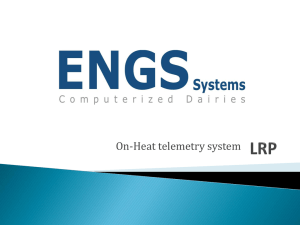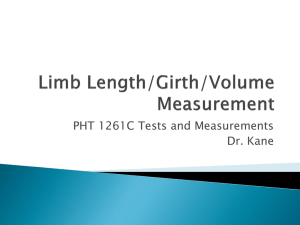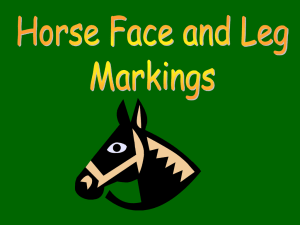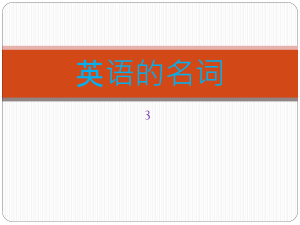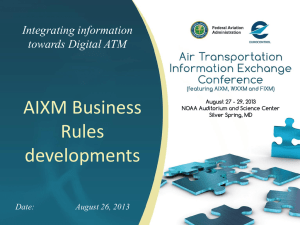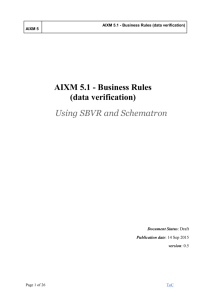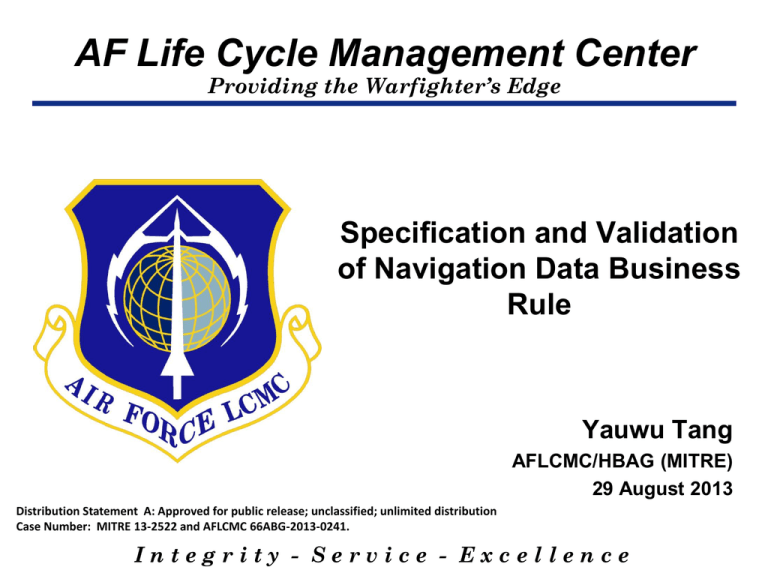
AF Life Cycle Management Center
Providing the Warfighter’s Edge
Specification and Validation
of Navigation Data Business
Rule
Yauwu Tang
AFLCMC/HBAG (MITRE)
29 August 2013
Distribution Statement A: Approved for public release; unclassified; unlimited distribution
Case Number: MITRE 13-2522 and AFLCMC 66ABG-2013-0241.
Integrity - Service - Excellence
Introduction
Providing the Warfighter’s Edge
ARINC-424 provides civil standards for preparation of navigation
databases (NavData); NavData loaded into Flight Management
Systems (FMS)
AIXM is next generation civil navigation data standard
ARINC-424 includes data base schema and business rules
AIXM schema provides syntax rules but not business rules
Free format business rule specifications are error prone (imprecise
and ambiguous)
Formal machine readable/executable method to specify business
rules defined in ARINC 424 and validate data using AIXM syntax
rules will:
Ensure precise and unambiguous business rule specification
Ensure consistent data validation at all stages of data chain process
©2013-The MITRE Corporation. All rights reserved.
Integrity - Service - Excellence
2
Introduction (concluded)
Providing the Warfighter’s Edge
Schematron Standard selected from the following candidates
SBVR (Semantic Business Vocabulary and Business Rules)
A formal natural language to specify business rule
Relative easy to use
Adapted by Eurocontrol
But it is not machine readable and executable
XML Schema Version 1.1
Provide limited assertion validation (borrowed from Schematron)
Schematron
Provide “assertion” and “report” validation rules for a given “context”
Human and machine readable
Can be enhanced with human readable descriptions
Provide free format text on failed assertion and successful report
Enable domain-specific diagnostic (error) messages
Human readable descriptions can be extracted and shown to subject matter
expert for review
Provides pointer from implementation to requirement (i.e., traceable
requirements)
©2013-The MITRE Corporation. All rights reserved.
Integrity - Service - Excellence
3
Overview
Providing the Warfighter’s Edge
This demonstration shows how Schematron can be used to
implement and validate ARINC 424 business rules for terminal
procedures using AIXM syntax rules
Schematron is an ISO standard language for making assertions about
the presence or absence of patterns in XML documents
Technical Approach
Using XSLT to embed all data
Using “Context” to specify applicable data elements
Using XPath 1.3 for math calculation including trigonometry
ARINC 424 rules analyzed
Schematron could be used to validate most ARINC-424 business rules
Five business rules from ARINC 424 Attachment 5 will be
demonstrated in this presentation
©2013-The MITRE Corporation. All rights reserved.
Integrity - Service - Excellence
Technical Approach
Providing the Warfighter’s Edge
Embedding all child data
Use XSLT to embed child data into the parent data file
Allow Schematron to access children data directly
Do not need Schematron to find child data using xlink
Using “Context” to specify rules for determining applicable
data elements
Using “Assert” and “Report” to describe rules
Check existence of attributes, value of attributes, counts of
attributes etc.
Present customized text and variable values to describe
errors
Using XPath 3.0 for math calculation including trigonometry
Use XPath variables to perform math calculations
Evaluate XPath variables in “Assert” and/or “Report” for
validation
©2013-The MITRE Corporation. All rights reserved.
Integrity - Service - Excellence
ARINC 424 Business Rule
Analysis
Providing the Warfighter’s Edge
ARINC 424.19 Attachment 5 contains business rules for
terminal procedures
Each business rule is analyzed to determine criteria for
applicable condition
Applicable condition categorized based on the coding
technique for the criteria
Each business rule is analyzed to determine the nature of
validation
Type of validation: Existence of attributes, Value of
attributes, Logic state of attributes, Counts of attributes
Involved elements/attributes: Can they be reached via
sibling relationship?
Sample business rules coded and verified
©2013-The MITRE Corporation. All rights reserved.
Integrity - Service - Excellence
Organization of Schematron
Rules
Providing the Warfighter’s Edge
More than one thousand rules will be needed for AIXM
Schematron Standard organizes rules in following hierarchy:
Need a way to organize them
Directory
Subdirectory
Files
Patterns
Rules
Assertion/Report
Directory, Subdirectory, and Files allow organization of rules
based on domain application and usage
Attributes on Patterns, Rules, and Assertion/Report will allow
us to add additional information for
Reference to requirements
Add additional natural language descriptions (such as Semantic Business Rule
Vocabulary (SBVR))
©2013-The MITRE Corporation. All rights reserved.
Integrity - Service - Excellence
Demonstration
Providing the Warfighter’s Edge
Five business rules from ARINC 424 Attachment 5
Demo 1: Validate Start/End Leg Type
Demo 2: Leg Sequence
Demo 3: Required Fields for a Leg
Demo 4: Non-Precision Approach Procedure
Demo 5: Entry and Exit an RF Leg in Tangent
Rules for Demo 1-3 are in AIXM 5.1 Business Rules
Use AIXM sample data from AIXM wiki
Use Oxygen with Saxon-EE 9.4.0.6 Schematron Validator
Definition of Leg Types can be found in ARINC 424.19 Attachment 5
©2013-The MITRE Corporation. All rights reserved.
Integrity - Service - Excellence
Demo 1: Validate Start/End Leg Type
Providing the Warfighter’s Edge
ARINC 424.19 Attachment 5 Section 1.2
©2013-The MITRE Corporation. All rights reserved.
Integrity - Service - Excellence
Demo 1: Validate Start/End Leg Type
(Sample Schematron Code)
Providing the Warfighter’s Edge
<sch:rule context="aixm-5.1:flightTransition [aixm5.1:ProcedureTransition/aixm-5.1:type eq 'APPROACH']">
<sch:assert test="./aixm-5.1:ProcedureTransition/aixm5.1:transitionLeg[1]//aixm-5.1:legTypeARINC = ('FC',
'FD', 'HF', 'IF', 'PI') and
./aixm-5.1:ProcedureTransition/aixm5.1:transitionLeg[last()]//aixm-5.1:legTypeARINC = ('AF',
'CF', 'CI', 'HF', 'HM', 'PI', 'RF', 'TF', 'VI')">
ARINC Specification 424, Attachment 5, Section 2.1,
Beginning and Ending Leg Types:
If the transition is an Approach Transition
then the beginning leg must be one of
FC, FD, HF, IF, PI and the end leg must
be one of AF, CF, CI, HF, HM, PI, RF, TF, VI.
</sch:assert>
</sch:rule>
©2013-The MITRE Corporation. All rights reserved.
Integrity - Service - Excellence
Demo 1: Validate Start/End Leg Type
Providing the Warfighter’s Edge
Test Data
One Instrument Approach Procedure
One Final Flight Transitions
Final Legs: CF, CF
Missed Approach legs: VA, VI, CF
Three Approach Flight Transitions
Approach Transition 1: CF, VI, CF
Approach Transition 2: IF, VI, CF
Approach Transition 3: IF, VI, CF
Test Scenario
Run Schematron validation and expect two errors
CF Legs can not be the Start Leg of a transition
Fix error (Change 1st legs from CF to IF)
Re-run Schematron validation, no more errors
©2013-The MITRE Corporation. All rights reserved.
Integrity - Service - Excellence
Demo 2: Leg Sequence
Providing the Warfighter’s Edge
ARINC 424.19 Attachment 5 Section 1.3
©2013-The MITRE Corporation. All rights reserved.
Integrity - Service - Excellence
Demo 2: Leg Sequence
Sample Schematron Code
Providing the Warfighter’s Edge
<sch:rule context="aixm-5.1:transitionLeg [.//aixm5.1:legTypeARINC eq 'VI'][following-sibling::aixm5.1:transitionLeg]">
<sch:assert test="following-sibling::aixm5.1:transitionLeg[.//aixm-5.1:legTypeARINC =
('AF','CF','CF','FA','FC','FD','FM','IF')]">>
If the current leg is VI then the next
leg must be one of AF,CF,FA,FC,FD,FM,IF
</sch:assert>
</sch:rule>
©2013-The MITRE Corporation. All rights reserved.
Integrity - Service - Excellence
13
Demo 2: Leg Sequence
Providing the Warfighter’s Edge
Test Data
One Instrument Approach Procedure
One Final Flight Transitions
Final Legs: IF, CF
Missed Approach legs: VA, VI, CF
Three Approach Flight Transitions
Approach Transition 1: IF, VI, CD
Approach Transition 2: IF, VI, CF
Approach Transition 3: IF, VI, CF
Test Scenario
Run Schematron validation and expect one errors
VI can not be followed with CD
Fix error (Change Leg CD to CF)
Re-run Schematron validation, no more errors
©2013-The MITRE Corporation. All rights reserved.
Integrity - Service - Excellence
Demo 3: Required Fields for a Leg
Providing the Warfighter’s Edge
ARINC 424.19 Attachment 5 Section 1.5
©2013-The MITRE Corporation. All rights reserved.
Integrity - Service - Excellence
Demo 3: Required Fields for a Leg
Sample Schematron code
Providing the Warfighter’s Edge
<sch:rule context="aixm-5.1:theSegmentLeg [.//aixm5.1:legTypeARINC = ('CA', 'CD', 'CI', 'CR', 'VA', 'VD', 'VI',
'VR')]">
<sch:assert test="not(.//(aixm-5.1:startPoint,aixm5.1:endPoint)//aixm5.1:pointChoice_fixDesignatedPoint//aixm5.1:designator)">
These legs: CA, CD, CI, CR, VA, VD, VI, VR
must not have a Waypoint Identifier in
either their start point or end point.
</sch:assert>
</sch:rule>
©2013-The MITRE Corporation. All rights reserved.
Integrity - Service - Excellence
16
Demo 3: Required Fields for a Leg
Providing the Warfighter’s Edge
Test Data
One Instrument Approach Procedure
One Final Flight Transitions
Final Legs: IF, CF
Missed Approach legs: VA, VI (w WP ID), CF
Three Approach Flight Transitions
Approach Transition 1: IF, VI (no WP ID), CF
Approach Transition 2: IF, VI (no WP ID), CF
Approach Transition 3: IF, VI (no WP ID), CF
Test Scenario
Run Schematron validation and expect one errors
VI Leg in Missed Approach has a WP ID
Fix error (Remove WP ID)
Re-run Schematron validation, no more errors
©2013-The MITRE Corporation. All rights reserved.
Integrity - Service - Excellence
Demo 4: Non-Precision
Approach Procedure
Providing the Warfighter’s Edge
ARINC 424.19 Attachment 5 Section 8.1.1: For approach procedures
without an electronic glide slope, the Final Approach Fix will be that
designated by government source. If no FAF is established in the
government source, one will be computed according to Rule 6.2.5.3
of this attachment. The fix, whether published or established, must
carry the Final Approach Fix Waypoint Description code of “F” in
position four of that code field. Note that only one record in a coded
approach procedure can carry the “F” in position four of the
Waypoint Description. Altitudes for this fix are coded in accordance
with Rule 6.2.10.1 of this attachment.
Schematron Rules: For Instrument Approach Procedure and Final
Flight Transition, there should be one and only one FAF point at
final legs
©2013-The MITRE Corporation. All rights reserved.
Integrity - Service - Excellence
Demo 4: Non-Precision Approach
Procedure
(Sample Schematron Code)
Providing the Warfighter’s Edge
<sch:rule context="aixm-5.1:InstrumentApproachProcedure [.//aixm5.1:approachType = ('ASR','ARA','ARSR','LDA','LDA_DME‘,
'LOC‘,'LOC_BC','LOC_DME','LOC_DME_BC','NDB','NDB_DME','SDF
','TLS','VOR','VOR_DME')]">
<sch:assert test="count(.//aixm-5.1:flightTransition[./aixm5.1:ProcedureTransition/aixm-5.1:type eq 'FINAL']//(aixm5.1:FinalLeg | aixm-5.1:IntermediateLeg | aixm5.1:InitialLeg)//aixm-5.1:role[. eq 'FAF']) eq 1">
ARINC Specification 424, Attachment 5, Section 8.1.1:
For approach procedures without an electronic
glide slope, the Final Approach Fix ... must carry
the Final Approach Fix Waypoint Description code of "F"
in position four of that code field.
Alternatively: For approach procedures without an
electronic glide slope, the final transition
must have a final leg with a final approach fix.
These procedures do not have an electronic glide slope:
ASR, ARA, ARSR, LDA, LDA_DME, LOC, LOC_BC,
LOC_DME, LOC_DME_BC, NDB, NDB_DME, SDF, TLS,
VOR, VOR_DME
</sch:assert>
</sch:rule>
©2013-The MITRE Corporation. All rights reserved.
Integrity - Service - Excellence
Demo 4: Non-Precision Approach
Procedure
Providing the Warfighter’s Edge
Test Data
One Instrument Approach Procedure
One Final Flight Transitions
Final Legs: IF (No FAF), CF (No FAF)
Three Missed Approach legs: VA, VI, CF
Three Approach Flight Transitions
Approach Transition 1: IF, VI, CF
Approach Transition 2: IF, VI, CF
Approach Transition 3: IF, VI, CF
Test Scenario
Run Schematron validation and expect one errors
No FAF at both final legs
Fix error (Change first CF leg from “no FAF” to “FAF”)
Re-run Schematron validation, no more errors
©2013-The MITRE Corporation. All rights reserved.
Integrity - Service - Excellence
Demo 5: Tangent to and from RF
Leg
Providing the Warfighter’s Edge
ARINC 424.19 Attachment 5 Section 8.7.3: The track in the transition
must be tangent to the arc
Schematron Rules: For Instrument Approach Procedure, an RF leg
is preceded with a TF leg and followed with another TF leg, then
Preceding TF leg must be perpendicular with the line from the
end point of the TF leg to center of the RF arc
The line from End point of the RF leg to the center of the RF arc
must be perpendicular to the following TF leg
RF
TF
Arc
Center
TF
©2013-The MITRE Corporation. All rights reserved.
Integrity - Service - Excellence
Demo 5: Tangent to and from RF Leg
(Sample Schematron Code)
Providing the Warfighter’s Edge
<sch:pattern id="RF-leg" see="ARINC specification 424-18, ???">
<sch:rule
context="aixm-5.1:InstrumentApproachProcedure//aixm5.1:flightTransition//aixm-5.1:transitionLeg [.//aixm-5.1:legTypeARINC eq
'TF'][following-sibling::aixm-5.1:transitionLeg[1][.//aixm-5.1:legTypeARINC
eq 'RF']][following-sibling::aixm-5.1:transitionLeg[2][.//aixm5.1:legTypeARINC eq 'TF']]">
-----------<sch:let name="Leg1-law-of-cosine-distance" value="math:acos((math:cos($Leg1-from-lat-radians) * math:cos($Leg1-to-latradians)*math:cos((-1*$Leg1-to-lon-radians) - (-1*$Leg1-from-lon-radians))) + (math:sin($Leg1-from-lat-radians)*math:sin($Leg1-to-latradians))) * $Earth-radius-NM" />
<sch:let name="Leg1-a" value="math:pow(math:sin($Leg1-dLat div 2),2 ) + math:cos($Leg1-from-lat-radians) * math:cos($Leg1-to-lat-radians)
* math:pow(math:sin($Leg1-dLon div 2),2)" />
<sch:let name="Leg1-c" value="2 * math:atan2(math:sqrt($Leg1-a),math:sqrt(1 - $Leg1-a))" />
<sch:let name="Leg1-Haversine-distance" value="$Leg1-c * $Earth-radius-NM" />
<sch:let name="Leg1-Bearing-raw" value="(math:atan2(math:sin($Leg1-to-lon-radians - $Leg1-from-lon-radians) * math:cos($Leg1-to-latradians),(math:cos($Leg1-from-lat-radians) * math:sin($Leg1-to-lat-radians)) - (math:sin($Leg1-from-lat-radians) * math:cos($Leg1-tolat-radians) * math:cos($Leg1-to-lon-radians - $Leg1-from-lon-radians))))" />
<sch:let name="Leg1-Bearing" value="($Leg1-Bearing-raw + (2 * math:pi())) mod (2*math:pi())" />
<sch:let name="Leg1-Bearing-degrees" value="$Leg1-Bearing * 180 div math:pi()" />
-------------
<sch:assert test="($Difference1 gt (90-$delta) and $Difference1 lt (90+$delta))
or ($Difference1 gt (270 - $delta) and $Difference1 lt (270 + $delta)) or
($Difference1 gt (-90 - $delta) and $Difference1 lt (-90 + $delta)) or
($Difference1 gt (-270 - $delta) and $Difference1 lt (-270 + $delta))">
For an RF Leg, the previous leg must be tangent to the arc.
</sch:assert>
</sch:rule>
Listed Code for illustration purpose, not complete
©2013-The MITRE Corporation. All rights reserved.
Integrity - Service - Excellence
Demo 5: Tangent to and from RF
Leg
Providing the Warfighter’s Edge
Test Data
34.7
One Instrument Approach Procedure
IF
TF
Approach Flight Transitions
34.6
RF
34.5
Leg 1: TF (34.606319, -118.430708)
Leg 2: TF (34.543858, -118.751711)
Leg 3: RF (34.356694, -118.8812920)
Arc Center (34.399844, -118.51055)
Leg 4: TF (34.165078, -118.810819)
Arc
Center
TF
34.3
34.2
-119
34.4
Wrong
Arc
Center
-118.8
-118.6
-118.4
-118.2
34.1
-118
Test Scenario
Run Schematron validation and expect one error
Fix error (Change Arc Center from -118.51055 to -118.71055)
Re-run Schematron validation, no more error
©2013-The MITRE Corporation. All rights reserved.
Integrity - Service - Excellence
Conclusion
Providing the Warfighter’s Edge
Benefits of using Schematron for AIXM business rules
It is precise
It can be used to validate actual data (no software
development)
It is understandable by domain expert
Can be enhanced with embedded SBVR or plain
text rules
©2013-The MITRE Corporation. All rights reserved.
Integrity - Service - Excellence
Recommendation
Providing the Warfighter’s Edge
Recommend to include as part of AIXM business
rules
Start with ARINC 424 Rules
©2013-The MITRE Corporation. All rights reserved.
Integrity - Service - Excellence
25



